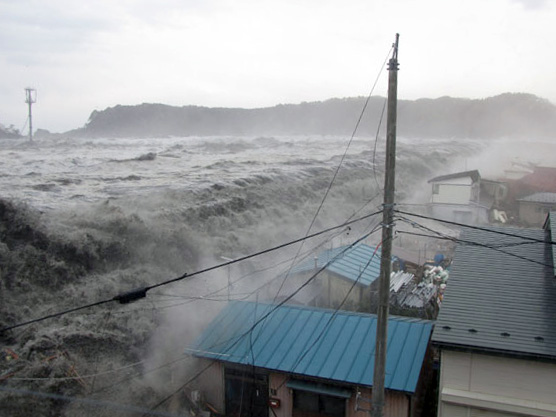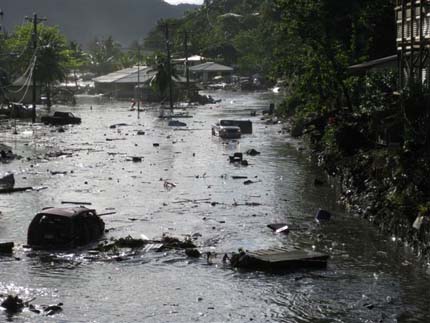What is a Tsunami?
A tsunami (tsoo-NAH-mee) is a series of waves caused by a major disturbance of a body of water. These waves can arrive in minutes, but may continue for hours. Tsunamis can be generated by a large coastal or underwater earthquake, landslide or volcanic eruption. Large meteorite impacts may also trigger tsunamis. All known sources capable of causing tsunamis are found within the Caribbean and its adjacent regions, and there are also distant sources across the Atlantic. Some countries within the region are also exposed to tsunamis along the Pacific coastlines.

Can Tsunamis Occur in the Caribbean and Adjacent Regions?
At least 75 tsunamis have impacted the Caribbean and adjacent regions in the past 500 years. Of these, almost 20 have caused deaths, and since 1842 it is estimated that more than 3000 people have been killed by these events. In the 2010 tsunami in Haiti, reports indicate that at least 7 lives were lost. Based on this historical evidence, the region can expect to experience approximately 4 destructive tsunamis per century. It is estimated that over 500,000 residents and visitors are exposed daily along the shores to this threat.
Sensing a Tsunami
In addition to tsunami alert messages issued by warning centres and national authorities, tsunamis may be accompanied by natural warning signs and recognizing any of these signs could save your life!

Before a Tsunami
- Contact your local authorities regarding the tsunami alerting procedures, threat and preparedness activities for your community.
- With the help of your local disaster management officials, identify the potentially vulnerable areas and assembly locations using inundation and evacuation maps where available. Specifically include your home and workplace in your discussions.
- Determine escape routes to high ground or inland, avoiding low lying coastal areas and river plains.
- In the nearby coastal areas, identify concrete, steel-reinforced multi-storey buildings preferable at least three-storeys that can possibly be used for vertical evacuation if necessary.
- Ensure that all family members and co-workers can recognize the natural tsunami warning signs, as timely, official Tsunami Warnings from authorities may not be possible.
- Prepare a tsunami emergency plan, and teach and practice your plan with all family members and co-workers.
- Prepare a safety backpack, including emergency supplies and equipment such as canned foods, medication, flashlights, battery-powered radios, clean water and first aid kits.
During a Tsunami
- Follow official guidance. However, if you recognize any of the natural tsunami warning signs, do not wait for an official warning before evacuating; authorities may not have enough time to issue a Tsunami Warning.
- If you are at the beach and recognize any of the natural tsunami warning signs – move immediately (preferably by foot) to an assembly point or higher ground. Abandon belongings; focus on saving your life, not your possessions.
- If you are unable to move to higher ground, go to an upper floor (preferably at least the 3rd storey) or roof of a concrete, steel-reinforced building.
- Sometimes tsunamis may occur without the initial pulling back of the sea. In this case, a massive wall of water may be seen approaching land. If you can see the wave you are already too close to outrun it.
- As a last resort, climb a strong tree if trapped on low ground.
- If time permits, vessels should navigate offshore to waters 100-400 meters deep.
- Prepare a safety backpack with all the essential items (at least water, non-perishable food, battery or hand held radio and flashlight) you will need if you are trapped have to evacuate.
- Tsunami waves may flood areas much further inland than storm surges. If swept up by a tsunami, look for something to use to keep you afloat.
- A tsunami is not a single wave, but a series of waves and very strong currents that can come ashore and affect beaches and harbours for hours. The first wave may not be the largest.
- If a Tsunami Warning is issued NEVER go down to the beach to watch the waves come in.
- Stay in the safe area until a recognised authority e.g. your local disaster management office issues the “ALL CLEAR, THIS MAY TAKE MANY HOURS.
After a Tsunami
If possible, stay tuned to a radio or television to get the latest emergency information. ONLY venture out of your safe area, return home or go to the coast when authorities give the ALL CLEAR indicating it is safe to do so.

Once the ALL CLEAR is given:
- Keep out of stagnant water.
- Stay out of damaged buildings.
- Help injured or trapped people if possible and call . for help if necessary.
- Check for damage to gas, sewer and water lines.
- Open windows and doors to help dry buildings.
- Check food supply and test drinking water.
- Fresh food that has come in contact with floodwater may be contaminated and should be discarded.
- Remove mud while it is still moist to give walls and floors an opportunity to dry.
Warning Information
Tsunami Warning Centres issue tsunami alert messages as advice to designated Tsunami Warning Focal Points.
These messages provide preliminary earthquake information and indicate whether or not there is a tsunami threat.
When tsunami waves are expected, the bulletins also include information on the countries that could be impacted, the expected arrival times and tsunami observations that have been made.
Only national and local government agencies have the authority to make decisions regarding the official state of alert in their area and any actions to be taken in response.
Messages may be updated, adjusted geographically, downgraded, or cancelled so you MUST monitor and follow the advice of your national and local authorities, but also be on alert for the natural tsunami warning signs. Local authorities may issue evacuation orders, but there may not be enough time, so EVACUATE if you recognize the natural warning signs.